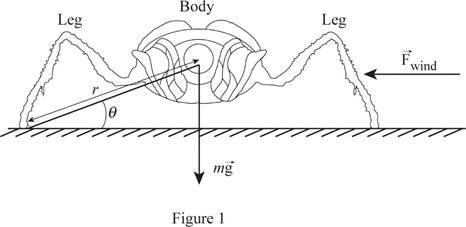
Concept explainers
(a)
The maximum wind speed that a blowfly can stand.
(a)
Answer to Problem 91P
The blowfly can stand a wind speed up to
Explanation of Solution
The cross-sectional area of the blowfly is
For the blowfly to stand the wind, the net torque on it will be zero. Consider the axis of the rotation to pass through the tip of the left leg.
The figure below shows the blowfly and different forces.

Write the formula for the condition to stand the wind.
Here,
Write the formula for the force due to wind.
Here,
Substitute equation (II) in equation (I).
Re-write the above equation to get an expression for
Conclusion:
Substitute
The blowfly can stand a wind speed up to
(b)
The maximum wind speed that a blowfly can stand when the angle is
(b)
Answer to Problem 91P
The blowfly can stand a wind speed up to
Explanation of Solution
The cross-sectional area of the blowfly is
For the blowfly to stand the wind, the net torque on it will be zero. Consider the axis of the rotation to pass through the tip of the left leg.
Write the formula for the condition to stand the wind.
Here,
Write the formula for the force due to wind.
Here,
Substitute equation (II) in equation (I).
Re-write the above equation to get an expression for
Conclusion:
Substitute
The blowfly can stand a wind speed up to
(c)
The maximum wind speed that a blowfly can stand when the angle is
(c)
Answer to Problem 91P
The blowfly can stand a wind speed up to
Explanation of Solution
The cross-sectional area of the blowfly is
For the blowfly to stand the wind, the net torque on it will be zero. Consider the axis of the rotation to pass through the tip of the left leg.
Write the formula for the condition to stand the wind.
Here,
Write the formula for the force due to wind.
Here,
Substitute equation (II) in equation (I).
Re-write the above equation to get an expression for
Conclusion:
Substitute
The blowfly can stand a wind speed up to
Want to see more full solutions like this?
Chapter 8 Solutions
Loose Leaf For Physics With Connect 2 Semester Access Card
 College PhysicsPhysicsISBN:9781305952300Author:Raymond A. Serway, Chris VuillePublisher:Cengage Learning
College PhysicsPhysicsISBN:9781305952300Author:Raymond A. Serway, Chris VuillePublisher:Cengage Learning University Physics (14th Edition)PhysicsISBN:9780133969290Author:Hugh D. Young, Roger A. FreedmanPublisher:PEARSON
University Physics (14th Edition)PhysicsISBN:9780133969290Author:Hugh D. Young, Roger A. FreedmanPublisher:PEARSON Introduction To Quantum MechanicsPhysicsISBN:9781107189638Author:Griffiths, David J., Schroeter, Darrell F.Publisher:Cambridge University Press
Introduction To Quantum MechanicsPhysicsISBN:9781107189638Author:Griffiths, David J., Schroeter, Darrell F.Publisher:Cambridge University Press Physics for Scientists and EngineersPhysicsISBN:9781337553278Author:Raymond A. Serway, John W. JewettPublisher:Cengage Learning
Physics for Scientists and EngineersPhysicsISBN:9781337553278Author:Raymond A. Serway, John W. JewettPublisher:Cengage Learning Lecture- Tutorials for Introductory AstronomyPhysicsISBN:9780321820464Author:Edward E. Prather, Tim P. Slater, Jeff P. Adams, Gina BrissendenPublisher:Addison-Wesley
Lecture- Tutorials for Introductory AstronomyPhysicsISBN:9780321820464Author:Edward E. Prather, Tim P. Slater, Jeff P. Adams, Gina BrissendenPublisher:Addison-Wesley College Physics: A Strategic Approach (4th Editio...PhysicsISBN:9780134609034Author:Randall D. Knight (Professor Emeritus), Brian Jones, Stuart FieldPublisher:PEARSON
College Physics: A Strategic Approach (4th Editio...PhysicsISBN:9780134609034Author:Randall D. Knight (Professor Emeritus), Brian Jones, Stuart FieldPublisher:PEARSON





